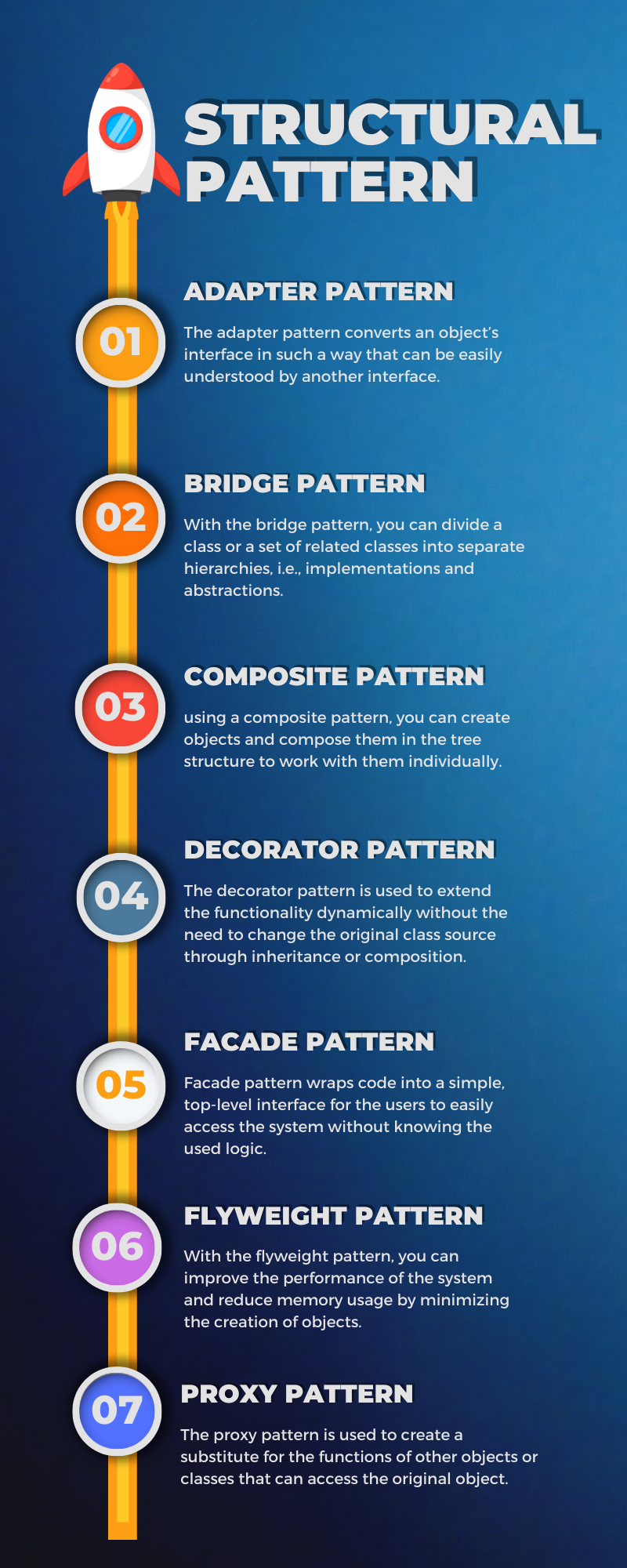Previously, we have covered behavioral and creational design patterns in our blogs. If you haven’t read them yet, we recommend doing so.
Structural Design Patterns will be the last in our design pattern series. And probably you were waiting for the same.
Read: Custom Web Application Design Patterns
So without further ado, let’s get into it.
Structural Design Pattern: An Overview
Structural design patterns deal with the way objects and classes are composed to form larger structures while keeping the structures efficient and flexible. To simplify the structure, relationships are identified.
Read: Design Patterns in Java
These patterns deal with the composition of classes and objects and the way they inherit each other. The structural pattern depends on concepts like interfaces and inheritance to allow multiple classes and objects to work together.
Types of Structural Design Patterns
There are seven types of structural design patterns. They are as follows:
-
Adapter Pattern
-
Bridge Pattern
-
Composite Pattern
-
Decorator Pattern
-
Facade Pattern
-
Flyweight Pattern
-
Proxy Pattern
Let’s understand each of these separately so that it becomes easier for you to use it in the future if needed.
This pattern allows communication between two incompatible interfaces with one. The adapter pattern converts an object’s interface in such a way that can be easily understood by another interface.
Read: Factory Design Patterns in Java
Using adapter patterns, developers can wrap the complexity of an interface, thus also known as the wrapper. However, one thing to remember is that even if the interface isn’t compatible, its functionality must meet the needs.
It allows a class or object to be accessed by multiple systems using different adapters and patterns. Thus, promotes the reusability of the existing interface in a system.
-
Bridge Pattern
With the bridge pattern, you can divide a class or a set of related classes into separate hierarchies, i.e., implementations and abstractions. Using a bridge pattern, you can build independent classes that work together.
Read: Template Method Design Pattern
Put simply, it separates implementations and abstractions from each other yet provides a way to interact and coexist.
While coding there’s a high chance of creating long nested classes. But determining the values of the object at the bottom will have to iterate throughout the structure, making it time-consuming and inefficient.
Read: Singleton Design Pattern
However, using a composite pattern, you can create objects and compose them in the tree structure to work with them individually. In simple terms, it allows you to operate on an object hierarchy.

If you have an existing object to that you want to add functionalities or additional responsibilities you can use the decorator pattern.
The decorator pattern is used to extend the functionality dynamically without the need to change the original class source through inheritance or composition. In short, the core benefit of using the decorator pattern is that it improves the functionality of the existing object.
To hide the complexity of an object interface, the Facade pattern is used. This pattern wraps code into a simple, top-level interface for the users to easily access the system without knowing the used logic.
Put simply, a project involves a lot of objects, classes, methods, logic, dependencies, etc. which makes it a lot more complex than we intend. Hence, using the Facade pattern we can create a simple interface that business logic uses to communicate and get work done.
-
Flyweight Pattern
With the flyweight pattern, you can improve the performance of the system and reduce memory usage by minimizing the creation of objects. This pattern looks for objects that already exist for reuse instead of creating new ones with similar functionalities.
Read: Observer pattern in Java
Moreover, it allows you to share the common state of multiple objects to fit more objects into available RAM rather than storing all the data in each object.
In simple terms, flyweight patterns suggest you stop keeping an extrinsic state inside an object and only pass these to specific methods relying on it.
The proxy pattern is used to create a substitute for the functions of other objects or classes that can access the original object.
To help you understand the concept of the proxy pattern, let us give you an example. While working on a project you use multiple objects that are connected to the database and use them to process user requests. But you might not want the database to stay connected with the given object all the time so you write instantiation to connect only when needed. However, it can be expensive.
On the other hand, using the proxy pattern allows clients to access original objects with different access rights. Here the client doesn’t directly connect with the original object rather the request call is redirected to the proxy object which in return calls the original objects’ methods.
Conclusion
So that was all about structural design patterns and their types. We hope this blog has given you a better understanding of what structural design patterns are and how they can be useful in your future projects.
Read: Types of Software Architecture Patterns
If you are a business owner who wants to build a web application to boost your reach in the market and gain more return on investment then hire developers who have years of experience and are highly proficient from Decipher Zone.
So what are you waiting for? Get in touch with us now!
.png)
FAQs
Q1. What is meant by structural pattern?
The structural pattern helps in identifying the relationships between objects and helps in identifying the structure. It explains the way objects and classes create larger structures while keeping these structures efficient and flexible.
Q2. What is the purpose of structural design patterns?
The structural pattern is used to show how unique objects can be combined in a way that makes the system extensible and flexible.
Q3. What are the types of structural design patterns?
The structural pattern is of seven types, namely adapter pattern, bridge pattern, composite pattern, decorator pattern, facade pattern, flyweight pattern, and proxy pattern.

